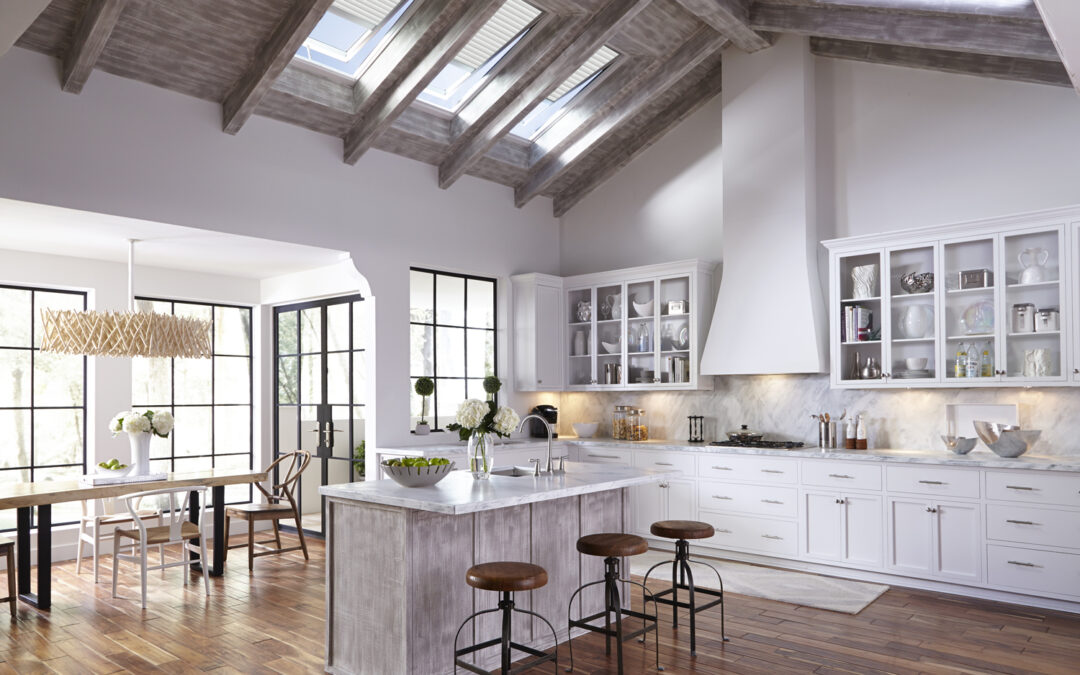When it comes to living environmentally friendly, homeowners have a lot of decisions to make. Everything from the materials we use to power our homes can impact our ecological footprint. Natural lighting, especially from skylights, is a great way to be more sustainable. Skylights are more than just a cool feature—they show we care about our planet and help make our homes more eco-friendly. Skylights not only save energy but also improve indoor air quality, lighting the path to a greener future.
Benefits of Skylights for Green Living
Skylights serve as a conduit for the Earth’s most abundant and underutilized resource: natural light. By harnessing the sun’s rays, skylights not only brighten our spaces but also promote a more energy-efficient way of life.
Natural Light and Energy Efficiency
It’s a simple equation: More natural light equals less need for artificial lighting. The beauty of skylights lies in their ability to infuse rooms with a soft, diffused glow that reduces the reliance on electricity during daylight hours. This natural light not only saves on utility bills but also offers a spectrum of benefits, from promoting a sense of well-being to enhancing the aesthetic of living spaces.
Reduced Dependence on Artificial Lighting
The typical home dedicates a significant portion of its electrical energy use to lighting. By integrating skylights strategically, homeowners can significantly cut back on this consumption, contributing to a lower carbon footprint. Skylights bridge the gap between the interior and the ever-changing sky, offering a dynamic interplay of light and an ever-present connection to the outside world without a flip of a switch.
Ventilation and Air Quality Improvement
Beyond lighting, skylights also facilitate natural ventilation. Opening skylights harness the chimney effect, utilizing warm air’s tendency to rise and escape through high openings. This not only keeps the home cooler and fresher but also minimizes the need for energy-intensive air conditioning, further reducing the household’s environmental impact.
Important Considerations When Adding Skylights
Installing skylights requires thoughtful planning and execution to ensure you get the most out of their use. Here are a few things you should consider:
Placement for Maximum Efficiency
Optimal placement is critical to ensuring skylights maximize their energy-saving potential. South-facing skylights receive the most direct sunlight throughout the day, making them the prime location for rooms that require consistent lighting. However, the angle of the roof and other factors may dictate alternate placements. Professional guidance is essential to finding the perfect balance between efficiency and practicality.
Energy-Saving Features
Modern skylights come with an array of features designed to enhance their energy performance. Low-emissivity coatings, double or triple glazing, and insulated frames all contribute to better thermal resistance, preventing heat loss in the winter and excess heat gain in the summer. Additionally, some skylights are equipped with sensors that automatically adjust blinds or shutters to optimize light levels and temperature.
Maintenance and Long-Term Benefits
Like any home feature, skylights require maintenance to ensure they continue to operate at their best. Regular cleaning and inspection of seals and mechanisms are necessary to prevent leaks and maintain energy efficiency. The long-term benefits of skylights, however, far outweigh the routine upkeep, as they can significantly increase the home’s value and appeal to potential buyers looking for eco-friendly homes.
Environmental Impact and Sustainability
The installation of skylights holds broad implications for home sustainability and the environment at large. Understanding how skylights stack up against traditional lighting methods and their overall contribution to energy conservation is key for the environmentally conscious homeowner.
Skylights vs. Traditional Lighting
In contrast to traditional incandescent and fluorescent lighting, skylights produce no greenhouse gas emissions and consume no energy. Even when compared to energy-efficient LED lighting, skylights offer a unique advantage by directly utilizing solar energy, a renewable resource that comes without a utility bill or environmental cost.
Contribution to Energy Conservation
By reducing a home’s electricity use, skylights actively contribute to reducing the demand for fossil fuel-generated power. This shift towards a more sustainable energy profile can be both environmentally profound and financially beneficial, as households with reduced energy consumption are less affected by rising energy costs.
Eco-friendly Materials and Design
The materials used in skylight construction can directly impact their environmental footprint as well. Opting for skylights made from sustainable or recycled materials and designed for easy recyclability at the end of their life can also enhance their positive contribution to the environment. Additionally, the design of skylights, such as their size and shape, can influence a home’s heating and cooling load, further improving energy efficiency.
The inclusion of skylights in a home represents a commitment to sustainable living. By embracing the renewable benefits of natural light and ventilation, skylights offer a harmonious blend of aesthetics, comfort, and eco-efficiency. For homeowners looking to enhance their green profile, skylights are an investment that pays dividends for both the environment and the future.
With the information provided, homeowners are encouraged to consider skylights as a compelling addition to their green living strategy. Whether it’s to bask in the sun’s glow or to lower the home’s environmental impact, skylights stand as beacons of green design in every home they grace.
Interested in elevating your home with the beauty and practicality of skylights? Follow the link to learn more about our skylight solutions, or reach out to us at (507) 718-1802 to discuss your project with an expert on our team!

